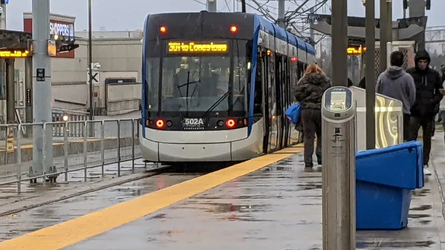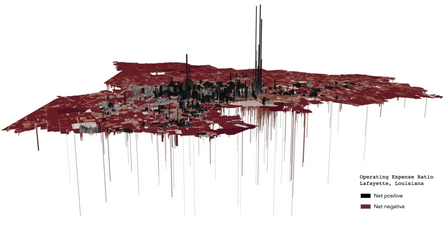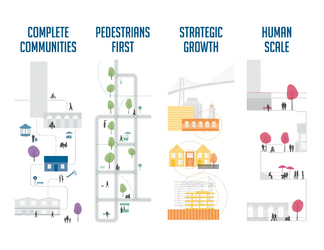From 'car-dependent hellscapes' to green cities, Canadians find new ways to fight climate change
To balance the books, Canadian cities make like Europe where going car-free is easy
Don Pittis · CBC News · Posted: Nov 21, 2022 4:00 AM ET | Last Updated: November 21
 While many cities across Canada sprawl out over farmland, a few, like Ontario's Waterloo Region, are making their communities more livable and climate friendly with smart public transit and concentrated development. (Don Pittis/CBC News)
While many cities across Canada sprawl out over farmland, a few, like Ontario's Waterloo Region, are making their communities more livable and climate friendly with smart public transit and concentrated development. (Don Pittis/CBC News)
Canadians pondering their household finances know that there are always more ideas about how to spend money than there is money to spend.
That universal economic principle was conspicuous at COP27, the latest version of the United Nations conference on climate change that
went into overtime this weekend in Sharm el-Sheikh, Egypt. A long list of competing demands for that cash included
compensation for climate damage,
biodiversity loss and
winding down the use of fossil fuels.
As governments at all levels consider the wisest use of tax revenue to avert a global climate catastrophe, there is growing evidence that urban development — that is, how Canada builds out its cities to accommodate
an expanding population — is the cornerstone of long-term climate policy.
And while disheartened critics worry that car-centric urban sprawl still underway cannot be stopped, there are new glimmers of hope as a growing wave of low-carbon, high-density, tax-efficient, people-friendly city-building shows signs of spreading.
"If we care about climate change, we need to make it easier to walk, cycle or use public transit. Period," said Jason Slaughter, a vigorous critic of automobile-centric urban development, who grew up in suburban London, Ont. Until he got a driver's licence at the age of 16, he said, he was trapped in what he calls a "car-dependent hellscape."
Our conversation was by email, partly because Slaughter's YouTube channel Not Just Bikes, a wry and sometimes hilarious collection of
sophisticated videos about urban design that has received millions of views keeps him busy, but also because he's in a different time zone. A famous Canadian export, he is a refugee from Canadian urban sprawl.
 A graphic created by the urban design company Urban3 for Lafayette, La. The upward spikes in densely urbanized parts of the city show areas of high tax productivity. The downward spikes are in widely spaced suburban developments, where revenues show a net cost to taxpayers. (Urban3)
A graphic created by the urban design company Urban3 for Lafayette, La. The upward spikes in densely urbanized parts of the city show areas of high tax productivity. The downward spikes are in widely spaced suburban developments, where revenues show a net cost to taxpayers. (Urban3)
"I fundamentally do not believe that Canadian cities will materially change within my lifetime, which is exactly why we gave up on Canada," said Slaughter in our exchange last week. "That's literally why our family left Canada to live in the Netherlands, permanently."
The shock value of that despairing comment is typical, but it is belied by his opus that includes hits like
Why I Hate Houston, an
attack on the widening of Wonderland Road in his hometown ("Fake London" as he describes it for his international audience) and what some considered an unfair critique of
Mississauga, Ontario's half-billion-dollar BRT system.
While written and delivered in a droll, contemptuous style, Slaughter's well-researched and well-produced videos, often in association with the
U.S. non-profit Strong Towns, provide an accessible lesson in what's not working in North American cities and, using his current home in the Netherlands as a counter-example, how North American cities need to change.
Tetris with too many squares
And while the task of turning the Titanic that is the current development model is enormous, there are signs that the seed Slaughter and others have planted is beginning to take root. That's especially true in Canada's biggest cities, simply as a matter of necessity, said David Gordon, a specialist in urban planning at Queen's University in Kingston, Ont.
"You cannot build a big city out of single detached houses with everybody driving," said Gordon on the phone last week as the COP27 conference was winding up.
He said that the urban centres of Vancouver, Montreal and Toronto have done a much better job than U.S. cities, where government funding structures have created downtown "inner city" blight that is unfamiliar in Canada's vibrant and pricey urban cores.
 Cars fill the highway to Vancouver International Airport. Canadians dream of detached houses and the freedom to drive on empty roads, but across North America, that's not the way things turned out. (CBC)
Cars fill the highway to Vancouver International Airport. Canadians dream of detached houses and the freedom to drive on empty roads, but across North America, that's not the way things turned out. (CBC)
For about 60 years Canadians have imagined the perfect
Leave it to Beaver lifestyle as "a detached house where you can drive everywhere on uncongested streets," said Gordon, but like a giant game of Tetris containing too many squares, continuous suburban sprawl results in traffic gridlock.
Gordon's research shows the suburban sprawl model
persists in medium-sized cities and outside urban cores partly because they have not yet reached the saturation point, but also because the model, including subsidies from existing provincial taxpayers, offers lucrative short-term profits for developers.
But as work by the Edmonton-based global design and engineering giant Stantec and others have shown, in the longer term, sprawl can lead to municipal government bankruptcy.
Suburbs don't pay
It is a difficult lesson learned by a number of U.S. cities that have simply run out of money to pay for crucial infrastructure repairs.
What Stantec's research for the city of Halifax showed, wonderfully illustrated by graphics produced by the urban design group Urban3, is that relatively crowded walkable downtown parts of a city produce huge amounts of tax revenue, whereas suburban low-density areas result in a net tax cost.
"A lot of our services are delivered on the linear foot, so the more you expand outward, the more pipe you have to run, the further your buses have to go, the further your waste delivery has to go," said Kate Greene, Halifax director of regional planning.
 Following a plan by Edmonton's Stantec that demonstrated the high cost of sprawl, and with the support of Mayor Mike Savage, Halifax has become a leader in smart, green, pedestrian-friendly growth. (Halifax Regional Municipality)
Following a plan by Edmonton's Stantec that demonstrated the high cost of sprawl, and with the support of Mayor Mike Savage, Halifax has become a leader in smart, green, pedestrian-friendly growth. (Halifax Regional Municipality)
What the tax productivity data shows is that "rich-people housing" with big lots and plenty of room for cars, which were subsidized when the neighbourhood was developed, continue to be subsidized throughout their long existence. Suburban single-family houses on big lots simply do not cover the municipal expense of things like repairing all that asphalt and clearing all that snow.
And in Halifax, turning itself into a relatively compact, walkable, climate-friendly city and shunning sprawl has become embedded in all planning decisions right up to the mayor's office.
"Our city is committed to economically and environmentally sustainable growth," said Halifax Mayor Mike Savage last week in an email. And it's not just hot air, outside experts like Gordon say Savage has been making it happen.
In the city of Guelph, the only Canadian municipality to be analyzed by Urban3, the city's senior urban designer David de Groot said the analysis came as a revelation. What it showed was that even the poorest areas of the urban centre provided vastly more municipal revenue than the sprawling fringes where the city had been spending its development resources.
WATCH | Visualizing the cost of development as cities sprawl:
The city has a beautiful, well-preserved downtown on a river that once powered its mills, and de Groot said since its first Urban3 study in 2014, Guelph has encouraged low- and medium-rise development in the core that has made it an increasingly vibrant place to live, work and visit.
"For its long-term sustainability, adding more people to the downtown was a critical direction for the city," said de Groot.
And decisions about today's development have effects that far outlast the profits of the developers.
Tax efficient equals green
"Land use planning affects the tax efficiency of communities and the energy efficiency of communities for decades, possibly centuries," said Kate Daley, Waterloo Region's designated expert on environmental sustainability.
The Ontario regional municipality spreads from the historic town of Galt north along the path of the Grand River, straddles Highway 401, and includes two of Canada's most prestigious universities as well as a lot of rural farmland — but it has adopted a development strategy that would not be entirely out of place in Slaughter's Europe.
As part of its goal to preserve farmland and green space, all connected by a central transit rail corridor where "The Ion" LRT runs, the region reached consensus last year on a plan called
Transform WR to build a "15-minute city," where everything is accessible by foot, by bike or by public transit. The strategy, the exact opposite of car-centric sprawl, intends to cut greenhouse gas emissions by 80 per cent by 2050.
Daley wrote a
book-length dissertation in 2017 describing what it was about Waterloo region — its people and its government — that allowed it to overcome popular dissent and the Ontario Municipal Board in order to "embrace smart growth policies" and new green growth.
Now that she is a regional employee, Daley said that kind of talk is off limits.
But she says the move to block sprawl has been a community-building exercise, and it has allowed the region to launch strategies that will be of interest to larger cities where car-dependence stands in the way of green innovation.
"Figuring out how to use future development and particularly intensification, to retrofit existing neighbourhoods into 15-minute neighbourhoods," said Daley, "that, I would say, is the bigger challenge."


























































